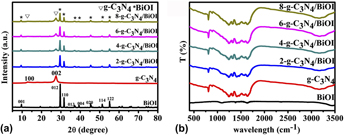Crossref Citations
This article has been cited by the following publications. This list is generated based on data provided by
Crossref.
Liu, Shuilian
Chen, Jianlin
Xu, Difa
Zhang, Xiangchao
and
Shen, Mengyao
2018.
Enhanced photocatalytic activity of directZ-scheme Bi2O3/g-C3N4composites via facile one-step fabrication.
Journal of Materials Research,
Vol. 33,
Issue. 10,
p.
1391.
Wang, Tao
Liu, Xiqing
Ma, Changchang
Liu, Yang
Dong, Hongjun
Ma, Wei
Liu, Zhi
Wei, Maobin
Li, Chunxiang
and
Yan, Yongsheng
2018.
A two step hydrothermal process to prepare carbon spheres from bamboo for construction of core–shell non-metallic photocatalysts.
New Journal of Chemistry,
Vol. 42,
Issue. 8,
p.
6515.
Huang, Danlian
Yan, Xuelei
Yan, Ming
Zeng, Guangming
Zhou, Chengyun
Wan, Jia
Cheng, Min
and
Xue, Wenjing
2018.
Graphitic Carbon Nitride-Based Heterojunction Photoactive Nanocomposites: Applications and Mechanism Insight.
ACS Applied Materials & Interfaces,
Vol. 10,
Issue. 25,
p.
21035.
Wang, Shuaijun
He, Fengting
Dong, Pei
Tai, Zhaoxin
Zhao, Chaocheng
Wang, Yongqiang
Liu, Fang
and
Li, Lin
2018.
Simultaneous morphology, band structure, and defect optimization of graphitic carbon nitride microsphere by the precursor concentration to boost photocatalytic activity.
Journal of Materials Research,
Vol. 33,
Issue. 23,
p.
3917.
Zhang, Jinfeng
Fu, Junwei
Wang, Zhongliao
Cheng, Bei
Dai, Kai
and
Ho, Wingkei
2018.
Direct Z-scheme porous g-C3N4/BiOI heterojunction for enhanced visible-light photocatalytic activity.
Journal of Alloys and Compounds,
Vol. 766,
Issue. ,
p.
841.
Xu, Yaxin
Li, Wenya
Lu, Jintao
Wang, Guilong
Dang, Yingying
Yang, Zheng
Gu, Yuefeng
Yang, Zhiyuan
and
Sui, Yupeng
2019.
Microstructural Evolution, Room‐ and High‐Temperature Mechanical Properties of Friction Welded Joints of a New Wrought Ni–Fe Based Superalloy.
Advanced Engineering Materials,
Vol. 21,
Issue. 8,
Shen, Rongchen
Xie, Jun
Xiang, Quanjun
Chen, Xiaobo
Jiang, Jizhou
and
Li, Xin
2019.
Ni-based photocatalytic H2-production cocatalysts2.
Chinese Journal of Catalysis,
Vol. 40,
Issue. 3,
p.
240.
Zhou, Rong-Hui
Wei, Zhi-He
Li, Yan-Yang
Li, Zhong-Jun
and
Yao, Hong-Chang
2019.
Construction of visible light–responsive Z-scheme CdS/BiOI photocatalyst with enhanced photocatalytic CO2 reduction activity.
Journal of Materials Research,
Vol. 34,
Issue. 23,
p.
3907.
Zammouri, Lobna
Aboulaich, Abdelhay
Capoen, Bruno
Bouazaoui, Mohamed
Sarakha, Mohamed
Stitou, Mostafa
and
Mahiou, Rachid
2019.
Synthesis of YAG:Ce/ZnO core/shell nanoparticles with enhanced UV-visible and visible light photocatalytic activity and application for the antibiotic removal from aqueous media.
Journal of Materials Research,
Vol. 34,
Issue. 08,
p.
1318.
Qiu, Taoyu
Zhu, Weiwei
Liu, Shaoyou
Chen, Kao
Liang, Siliang
and
Feng, Qingge
2019.
Solid state synthesis and characterization of n–p (SnO2)1.3/(α ∼ Bi2O3)x/(β ∼ Bi2O3)1−x photocatalyst modulated by PVA and its photocatalytic performance.
Journal of Materials Research,
Vol. 34,
Issue. 10,
p.
1805.
He, Rongan
Cheng, Kaiyu
Wei, Zheying
Zhang, Shiying
and
Xu, Difa
2019.
Room-temperature in situ fabrication and enhanced photocatalytic activity of direct Z-scheme BiOI/g-C3N4 photocatalyst.
Applied Surface Science,
Vol. 465,
Issue. ,
p.
964.
Chang, Chi-Jung
Lin, Yan-Gu
Chao, Pei-Yao
and
Chen, Jem-Kun
2019.
AgI-BiOI-graphene composite photocatalysts with enhanced interfacial charge transfer and photocatalytic H2 production activity.
Applied Surface Science,
Vol. 469,
Issue. ,
p.
703.
Wu, Shizi
Xie, Yao
Zhang, Xianmei
Huang, Zhaohui
Liu, Yangai
Fang, Minghao
Wu, Xiaowen
and
Min, Xin
2019.
In situ synthesis of adsorptive β-Bi2O3/BiOBr photocatalyst with enhanced degradation efficiency.
Journal of Materials Research,
Vol. 34,
Issue. 20,
p.
3450.
Li, Yeping
Wang, Qian
Huang, Liying
Xu, Xiuquan
Xie, Meng
Wang, Hao
Huang, Shuquan
Zhang, Fei
Zhao, Zhengyun
and
Yang, Juan
2019.
Enhanced LED-light-driven photocatalytic antibacterial by g-C3N4/BiOI composites.
Journal of Materials Science: Materials in Electronics,
Vol. 30,
Issue. 3,
p.
2783.
Ghosh, Utpal
and
Pal, Anjali
2019.
Graphitic carbon nitride based Z scheme photocatalysts: Design considerations, synthesis, characterization and applications.
Journal of Industrial and Engineering Chemistry,
Vol. 79,
Issue. ,
p.
383.
Kumar, A. Madhan
Khan, Abuzar
Khan, Mohd Yusuf
Suleiman, Rami K.
Jose, Jobin
and
Dafalla, Hatim
2020.
Hierarchical graphitic carbon nitride-ZnO nanocomposite: Viable reinforcement for the improved corrosion resistant behavior of organic coatings.
Materials Chemistry and Physics,
Vol. 251,
Issue. ,
p.
122987.
Zhang, Peng
Jian, Xiaojuan
Tan, Jianhong
Ran, Yuanming
and
Zhang, Guoqing
2020.
Ag/AgBr coupled low crystalline Nb2O5 as an effective photocatalyst for the degradation of rhodamine B.
Journal of Materials Research,
Vol. 35,
Issue. 13,
p.
1692.
Shen, Qianhong
Wu, Chengyan
You, Zengyu
Huang, Feilong
Sheng, Jiansong
Zhang, Fang
Cheng, Di
and
Yang, Hui
2020.
g-C3N4 nanoparticle@porous g-C3N4 composite photocatalytic materials with significantly enhanced photo-generated carrier separation efficiency.
Journal of Materials Research,
Vol. 35,
Issue. 16,
p.
2148.
Shafawi, Anis Natasha
Mahmud, Rabiatul Aliah
Ahmed Ali, Khozema
Putri, Lutfi Kurnianditia
Md Rosli, Noor Izzati
and
Mohamed, Abdul Rahman
2020.
Bi2O3 particles decorated on porous g-C3N4 sheets: Enhanced photocatalytic activity through a direct Z-scheme mechanism for degradation of Reactive Black 5 under UV–vis light.
Journal of Photochemistry and Photobiology A: Chemistry,
Vol. 389,
Issue. ,
p.
112289.
Li, Yuzhen
Li, Zhen
Xia, Yunsheng
Li, Houfen
Shi, Jianhui
Zhang, Aiming
Huo, Haohao
Tan, Siyang
and
Gao, Lizhen
2021.
Fabrication of ternary AgBr/BiPO4/g-C3N4 heterostructure with dual Z-scheme and its visible light photocatalytic activity for Reactive Blue 19.
Environmental Research,
Vol. 192,
Issue. ,
p.
110260.



